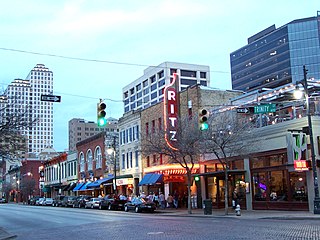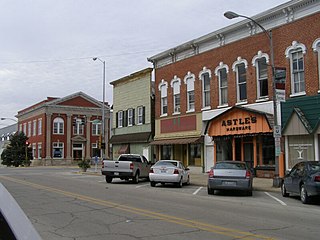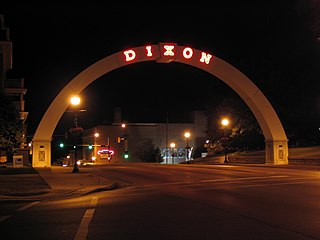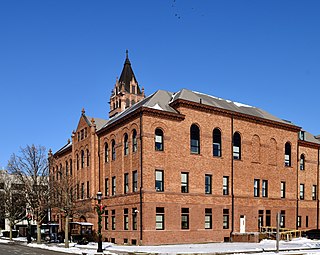
Sixth Street is a historic street and entertainment district in Austin, Texas, located within the city's urban core in downtown Austin. Sixth Street was formerly named Pecan Street under Austin's older naming convention, which had east–west streets named after trees and north–south streets named after Texas rivers.

The Sycamore Historic District is a meandering area encompassing 99 acres (400,000 m2) of the land in and around the downtown of the DeKalb County, Illinois, county seat, Sycamore. The area includes historic buildings and a number of historical and Victorian homes. Some significant structures are among those located within the Historic District including the DeKalb County Courthouse and the Sycamore Public Library. The district has been listed on the National Register of Historic Places since May 2, 1978.

The commercial buildings in the Sycamore Historic District, located in Sycamore, Illinois, United States are mostly located in and around the city's downtown. The largest concentration of commercial contributing properties to the historic district are found along Illinois Route 64 as it passes through Sycamore. They include several buildings known as "blocks" which can consist of more than one adjacent and attached structure, as is the case with the Waterman Block, one of the Sycamore commercial buildings.

The Galena Historic District is a historic district located in the city of Galena, Illinois, USA. The historic district encompasses 85 percent of the city of Galena and includes more than 800 properties. The downtown area consists of three successive tiers made up of Main, Bench and Prospect Streets. Within the boundaries of the district are such notable homes as the Ulysses S. Grant Home and the Elihu B. Washburne House. The Galena Historic District was added to the U.S. National Register of Historic Places in 1969.

The Central Troy Historic District is an irregularly shaped, 96-acre (39 ha) area of downtown Troy, New York, United States. It has been described as "one of the most perfectly preserved 19th-century downtowns in the [country]" with nearly 700 properties in a variety of architectural styles from the early 19th to mid-20th centuries. These include most of Russell Sage College, one of two privately owned urban parks in New York, and two National Historic Landmarks. Visitors ranging from the Duke de la Rochefoucauld to Philip Johnson have praised aspects of it. Martin Scorsese used parts of downtown Troy as a stand-in for 19th-century Manhattan in The Age of Innocence.

The Fort Madison Downtown Commercial Historic District has a collection of late-19th century store fronts centered on Ave. G, from 6th to 9th Street, and Ave. H from 7th to 9th, in Fort Madison, Iowa. It was listed on the National Register of Historic Places in 2007.

There are nine historic districts in Meridian, Mississippi. Each of these districts is listed on the National Register of Historic Places. One district, Meridian Downtown Historic District, is a combination of two older districts, Meridian Urban Center Historic District and Union Station Historic District. Many architectural styles are present in the districts, most from the late 19th century and early 20th century, including Queen Anne, Colonial Revival, Italianate, Art Deco, Late Victorian, and Bungalow.

The Greenwich Avenue Historic District is a historic district representing the commercial and civic historical development of the downtown area of the town of Greenwich, Connecticut. The district was listed on the National Register of Historic Places on August 31, 1989. Included in the district is the Greenwich Municipal Center Historic District, which was listed on the National Register the year before for the classical revival style municipal buildings in the core of Downtown. Most of the commercial buildings in the district fall into three broad styles, reflecting the period in which they were built: Italianate, Georgian Revival, and Commercial style. The district is linear and runs north–south along the entire length of Greenwich Avenue, the main thoroughfare of Downtown Greenwich, between U.S. Route 1 and the New Haven Line railroad tracks.

The Spring–Douglas Historic District is a set of 496 buildings in Elgin, Illinois. Of those, 455 buildings contribute to the district's historical value. It is a residential district following Spring Street and Douglas Avenue from Kimball Street in the south to River Bluff Road to the north. The lands that now comprise the district were originally settled by Phineas J. Kimball and Vincent Lovell in the 1830s. Kimball's property eventually became the southern part of the district, which mostly housed working class citizens. Lovell's subdivisions became housing for wealthier managers and doctors. The lower district is noted for its vernacular architecture, mostly gablefront houses, while the upper district represents a wide array of late 19th and early 20th century styles, mostly Queen Anne.

The Moline Downtown Commercial Historic District is a nationally recognized historic district located in Moline, Illinois, United States. Centered on 5th Avenue, it is roughly bounded by 12th Street to 18th Street, 4th Avenue to 7th Avenue. The distinct covers 33-acre (0.13 km2) and includes 114 buildings. One hundred of the buildings contribute to the significance of the district because they retain their historic and architectural integrity and reflect the character of the historic downtown.

The Blair Historic District is a historic district located in downtown Belleville, Illinois. The district encompasses a mainly commercial area on the west side of the downtown area; it includes 78 buildings, 57 of which are contributing buildings. The entire district is located within the original plat of the city, which was established following a land donation from George Blair in 1813. The oldest buildings in the district date to circa 1850; development continued from then on into the early twentieth century. Most buildings in the district are two-part brick commercial blocks designed in popular contemporary styles such as the Italianate, Second Empire, Classical Revival, and Romanesque Revival. The Reichert Business Block, a three-story structure at 200 West Main Street, has a particularly significant Second Empire design; the building features a mansard roof with dormers and a decorative cornice and has been described as the district's most elaborate building. Two Classical Revival buildings, the 1911 United States Post Office Building and the 1924 Turner Hall, also have a commanding presence in the district; the post office was designed by Supervising Architect James Knox Taylor.

The Downtown Commercial Historic District encompasses most of the central business district of Burlington, Iowa, United States. It was listed on the National Register of Historic Places in 2015. The historic district includes 65 properties that were part of a 2012 to 2013 survey of the area. It also includes as contributing properties the buildings in the West Jefferson Street Historic District and three buildings in the Manufacturing and Wholesale Historic District that were previously listed on the National Register. All total there are 122 resources within the district, which includes 108 contributing and 14 non-contributing properties.

The Morrison Main Street Historic District is a national historic district in Morrison, Illinois. The district encompasses an eight-block commercial area in downtown Morrison and includes 65 buildings, 53 of which are contributing buildings. Development in the district began in the 1850s, the same decade that Morrison was platted and incorporated, and continued through the mid-20th century. The district's growth was tied to the city's primarily agricultural economy and was spurred by its access to the Chicago and North Western Railway in the 19th century and the Lincoln Highway in the 20th. The most prevalent architectural styles in the district are Italianate and High Victorian Eclectic, both of which were most popular in the mid-to-late 19th century; other styles which can be found in the district include Romanesque Revival, Commercial, Classical Revival, Modernist, and various vernacular designs.

The Downtown Momence Historic District is a national historic district which encompasses the commercial core of downtown Momence, Illinois. The district includes 49 contributing buildings, all but two of which are commercial buildings; the remaining two are residential. While the oldest building in the district dates to 1849, significant development in downtown Momence did not begin until the Chicago, Danville and Vincennes Railroad reached the city in 1871. Roughly one-third of the district's buildings, primarily retail stores, were built between 1871 and 1900. Most of the remaining buildings were built between 1900 and 1930; these were more diverse and included banks, entertainment and recreational facilities, and automobile-related businesses toward the end of the period. The architectural styles seen in the district are representative of American commercial architectural trends of the late 19th and early 20th centuries; the majority of the buildings have Italianate designs, though examples of Greek Revival, Classical Revival, and Romanesque Revival architecture can also be found in the district.

The Dixon Downtown Historic District is a historic district which encompasses 154 properties in downtown Dixon, Illinois. The district includes the city's commercial core, which includes buildings dating back to the 1850s. Dixon's commercial buildings are largely two-story brick structures and reflect the popular architectural styles of their era of construction; the Italianate style is most common in 19th-century buildings, while the Commercial style and revival styles such as Neoclassical and Beaux-Arts became popular after 1900. Many of Dixon's prominent government and community buildings also lie within the district, including the Lee County Courthouse, City Hall, its current and former post offices, and several churches. A residential section on the west side of the district includes Queen Anne and Craftsman style homes; the former style was popular in the late 19th century, while the latter was popular in the early 20th.

The Ottawa Commercial Historic District is a historic district in downtown Ottawa, Illinois. The district includes 195 buildings and structures, most of them commercial buildings, spread out over 26 city blocks. The oldest buildings in the district, located near the Illinois and Fox rivers, were built in the 1830s. The district expanded northward toward the Illinois & Michigan Canal over time, and the buildings in its northern half date to the mid-to-late 19th and early 20th centuries. The district's buildings include most popular Midwestern architectural styles from the mid-19th century through the mid-20th century; some of the most common are vernacular frame buildings from the early years of the district's growth, Italianate buildings from the mid-19th century, Commercial style buildings from the early 20th century, and International Style buildings from the mid-20th century.

The Rochelle Downtown Historic District is a national historic district in downtown Rochelle, Illinois. The district includes 56 buildings, most of which are commercial buildings. Commercial development in Rochelle began in the 1850s, but several fires burned down all of the earliest buildings; the oldest surviving buildings in the district were built in 1871. Development in the district continued through the mid-twentieth century. While a variety of architectural styles can be found in the district, Italianate and vernacular commercial designs are the most common. Noteworthy non-commercial buildings in the district include the City and Town Hall, U.S. Post Office, Masonic Temple, and Chicago & North Western Railway depot.

The LaSalle Downtown Commercial District is a national historic district in downtown LaSalle, Illinois. The district encompasses 93 contributing buildings which historically formed the commercial and governmental center of LaSalle. Development in downtown LaSalle began with the completion of the Illinois and Michigan Canal in 1837 and the construction of railroads through the city in the 1850s; it continued through the mid-twentieth century. The district's commercial buildings represent many architectural styles, with popular styles of the late nineteenth century such as Italianate, Queen Anne, and Romanesque Revival being the most common. Significant government buildings include the LaSalle City Building and two post office buildings.

The Downtown Urbana Historic District is a commercial historic district encompassing seven city blocks in downtown Urbana, Illinois. The buildings in the district reflects downtown Urbana's development as the county seat of Champaign County and a regional commercial center. While Urbana was founded in the 1830s and began its development in the ensuing decades, the oldest buildings in the district are from the 1870s. The city expanded considerably in the late nineteenth and early to mid twentieth centuries, and most of the district's buildings were constructed during this period. Local architect Joseph Royer designed many of the district's most prominent buildings, including the 1901 Romanesque Revival Champaign County Courthouse.

The Champaign Downtown Commercial District is a commercial historic district encompassing 19.4 acres (7.9 ha) in downtown Champaign, Illinois. The district includes some of the oldest parts of the city's downtown, and its buildings represent the city's development in the late nineteenth and early twentieth centuries. Champaign was founded in the 1850s when the Illinois Central Railroad added a station in a rural area west of neighboring Urbana and the town formed around it; the oldest buildings in the district date from the following decade. Several buildings connected to the Illinois Central are included in the district. The opening of the University of Illinois at Urbana–Champaign in 1867 furthered Champaign's growth, and development in the downtown commercial district continued steadily through 1940. The district's commercial buildings exhibit a variety of building types and architectural styles, including Italianate, Art Deco, and various revival styles. Champaign's City Building and other local government buildings are also part of the district.






















